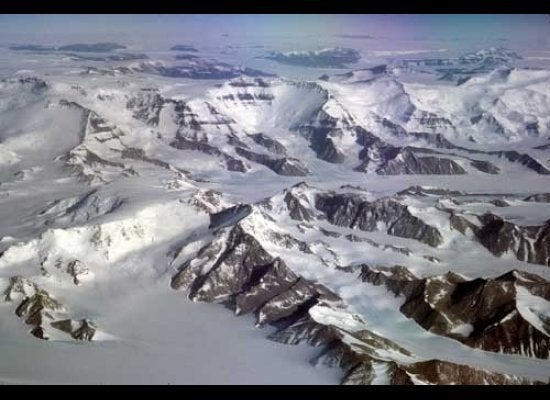The fourth segment of our tour of the Transantarctic Mountains boasts the most spectacular scenery and the southernmost outcropping of rock on the planet. This is also the most remote and difficult region to reach. The final portion of the Transantarctic Mountains to be sighted was the 170-mile stretch between Beardmore Glacier, where we left off last time, and Liv Glacier, navigated by Richard Byrd on November 28, 1929, on his flight to the South Pole. On Feb. 29, 1940, during the U. S. Antarctic Service Expedition, a flight from Little America closed the unsighted gap, recording high, blocky ranges with horizontal layers at their tops, and a major outlet glacier now named the Shackleton.
To the east of Liv Glacier is Mt. Fridtjof Nansen, named by Roald Amundsen for his mentor and fellow Norwegian. At 13,353 feet, this towering massif dominates one of the narrowest stretches of the Transantarctic Mountains. On its southern flank is Axel Heiberg Glacier, the route that Amundsen's party used to reach the polar plateau and thence the South Pole. They traversed only 25 miles of the glacier while climbing nearly 8,000 feet, avoiding the steepest of the icefalls, and arriving on the plateau four days after they had left the ice shelf at the base of the mountains.
Following Byrd's successful flight to the Pole, a ground party led by geologist Laurence Gould, which had been positioned at the mouth of Liv Glacier to radio weather reports, traversed eastward along the mountain front. They discovered the next major outlet glacier, Amundsen Glacier, followed by Scott Glacier, arguably the most scenic portion of the entire Transantarctic Mountains, ending their traverse east of the mouth of the Scott at a peak they called Supporting Party Mountain. The high, horizontal layering that dominates the mountains as far as Mt. Fridtjof Nansen, and gives them their blocky appearance, thins and retreats toward the plateau further on, exposing a vast terrain of granite where erosion has rendered a spectacular array of intricate ridgelines and summits.
The exploration of Scott Glacier occurred in 1934-35, when a three-man party of Byrd's Second Antarctic Expedition, led by geologist Quin Blackburn, mushed dog teams to the head of the glacier. There they discovered Mt. Howe, a low wharf at the edge of the icy inland sea, southernmost outcrop of rock, Earth's land's end. Twenty-five miles north of Mt. Howe is Mt. Early, the world's southernmost volcano. Isotopic dating has shown that this small cone erupted into the overlying ice sheet 16 million years ago, likely in an event similar to those witnessed in recent years in Iceland, where magma erupts into glaciers.
The central portion of Scott Glacier claims the most spectacular scenery throughout the Transantarctic Mountains. On the west side of the glacier, ridgelines gracefully rise to a tiara of massive summits, collectively called the Hays Mountains, with Mt. Astor, at 12,170 feet, the jewel of the crown. On the east side of Scott Glacier, a magnificent set of solitary peaks, known as the Gothic Mountains, encircles the sheltered Sanctuary Glacier. Foremost amongst these are the Organ Pipe Peaks and their central spire, The Spectre, whose faceted prow rises 2,000 feet straight out of the ice, and remains the unclaimed prize of extreme mountaineers.
To the east of Scott Glacier the Transantarctic Mountains continue for another 175 miles, diminishing in width and relief until they are reduced to a single, low escarpment in the Ohio Range, beyond which the East and West Antarctic Ice Sheets merge, completely inundating the mountains.
This ends our virtual tour of the Transantarctic Mountains. We have come 1,200 miles from northern Victoria Land to Scott Glacier. Real tourists can access coastal portions of Victoria Land on ships that ply the Ross Sea. The interior portions of the mountains are reachable only by air; however, a service exists that can, for serious money, fly you anywhere in the Transantarctic Mountains. For a more detailed account of the geography and history of discovery of the Transantarctic Mountains, see my book "The Roof at the Bottom of the World." Never stop exploring!
<
>
